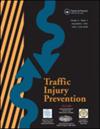基于车辆轨迹数据的交通事故风险预测。
IF 1.6
3区 工程技术
Q3 PUBLIC, ENVIRONMENTAL & OCCUPATIONAL HEALTH
引用次数: 0
摘要
研究目的本研究的目的是利用车辆轨迹数据对交通事故进行精确的风险预测:方法:针对城市道路和高速公路场景,开发了一套从车载设备收集车辆运动学数据和驾驶操作记录的方案。对 3000 多辆车的原始轨迹样本进行了清洗、过滤、插值和归一化等预处理。比较了基于 RNN、CNN 和 LSTM 的三种深度学习框架。构建了端到端的 LSTM 事故风险预测模型,并使用交叉熵损失函数和 Adam 优化器对模型进行了训练:结果:LSTM 模型能够直接从低质量的原始轨迹数据中提取与事故相关的危险状态特征,从而以精细的时间分辨率预测事故概率。在复杂交通场景下进行的测试中,该模型成功识别了高速路段和交叉路口的高风险驾驶行为,预测准确率达到 0.89,显示出较强的泛化性能:本研究开发的基于车辆轨迹的 LSTM 事故风险预测模型能够智能地提取危险驾驶特征。结论:本研究开发的基于车辆轨迹的 LSTM 事故风险预测模型能够智能提取危险驾驶特征,准确预警交通事故风险,为加强道路安全提供了一种新方法。本文章由计算机程序翻译,如有差异,请以英文原文为准。
Prediction of traffic accident risk based on vehicle trajectory data
Objective
The objective of this study is to conduct precise risk prediction of traffic accidents using vehicle trajectory data.
Methods
For urban road and highway scenarios, a scheme was developed to gather vehicle kinematic data and driving operation records from an in-vehicle device. The raw trajectory samples of over 3000 vehicles were processed through cleaning, filtering, interpolation, and normalization for preprocessing. Three deep learning frameworks based on RNN, CNN, and LSTM were compared. An end-to-end LSTM accident risk prediction model was constructed, and the model was trained using the cross-entropy loss function with Adam optimizer.
Results
The LSTM model is capable of directly extracting accident-related hazardous state features from low-quality raw trajectory data, thereby enabling the prediction of accident probability with fine-grained time resolution. In tests conducted under complex traffic scenarios, the model successfully identifies high-risk driving behaviors in high-speed road sections and intersections with a prediction accuracy of 0.89, demonstrating strong generalization performance.
Conclusions
The LSTM accident risk prediction model, based on vehicle trajectory, developed in this study, is capable of intelligently extracting dangerous driving features. It can accurately warn about the risk of traffic accidents and provides a novel approach to enhancing road safety.
求助全文
通过发布文献求助,成功后即可免费获取论文全文。
去求助
来源期刊

Traffic Injury Prevention
PUBLIC, ENVIRONMENTAL & OCCUPATIONAL HEALTH-
CiteScore
3.60
自引率
10.00%
发文量
137
审稿时长
3 months
期刊介绍:
The purpose of Traffic Injury Prevention is to bridge the disciplines of medicine, engineering, public health and traffic safety in order to foster the science of traffic injury prevention. The archival journal focuses on research, interventions and evaluations within the areas of traffic safety, crash causation, injury prevention and treatment.
General topics within the journal''s scope are driver behavior, road infrastructure, emerging crash avoidance technologies, crash and injury epidemiology, alcohol and drugs, impact injury biomechanics, vehicle crashworthiness, occupant restraints, pedestrian safety, evaluation of interventions, economic consequences and emergency and clinical care with specific application to traffic injury prevention. The journal includes full length papers, review articles, case studies, brief technical notes and commentaries.
 求助内容:
求助内容: 应助结果提醒方式:
应助结果提醒方式:


